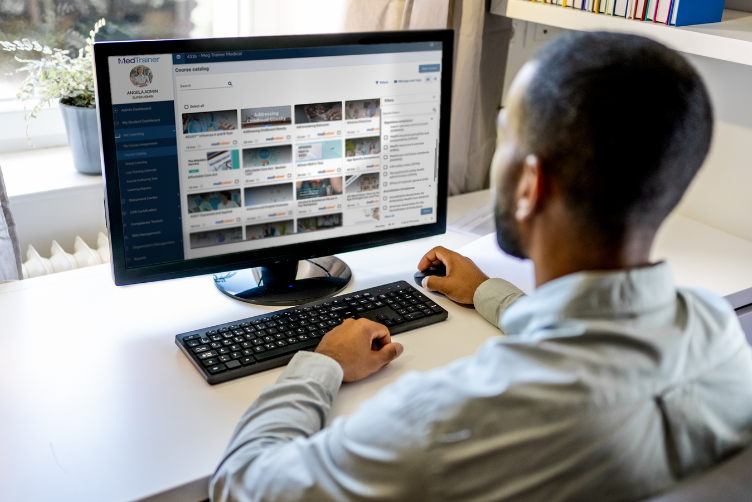The healthcare landscape is rapidly evolving, with projected growth in employment by 16% between 2020 and 2030 and the industry’s value expected to double to $7 trillion by 2025. Maintaining compliance at this pace of growth will almost certainly require healthcare training software to manage the volume and maintain efficiency.
Before purchasing software, identify key healthcare learning management system (LMS) features to help your organization streamline training processes and enhance learning outcomes. Given the market’s growth and the critical nature of healthcare education, selecting a suitable LMS is more crucial than ever.
Evolution of Healthcare Compliance Training
In-Person Training
Healthcare workers in the field for a few decades are accustomed to completing compliance training in-person. Schedules are blocked, lunch is ordered, and a compliance officer or another staff member delivers the training. As training requirements increased, more expertise was needed, so the process evolved to include someone rolling in a TV on a cart. When regulations started requiring proof employees had completed the training, a sheet of paper was passed around for everyone to sign.
Hybrid Training
Regulations have increased the volume of required education to the point that halting a facility’s operations to conduct hours and hours of training is just not possible. Clinical and facilities staff are required to complete 10+ hours of training every year. As a result, most organizations began adopting a hybrid model that uses some technology combined with manual processes. Maybe the compliance officer finds a few trainings online (find out why YouTube is not recommended), purchases a couple from a vendor, and conducts one or two in person. Course completion tracking is typically done in a spreadsheet or kept in a binder.
Healthcare Training Software
Now, with high staff turnover and decreasing profit margins, healthcare workers are being asked to do more. All the manual tracking and assigning take time from compliance teams, and employees are frustrated searching for multiple logins and constantly stopping and restarting training videos. Healthcare training software simplifies the process for everyone involved while ensuring content and data accuracy. It’s why the healthcare LMS market is on a trajectory to exceed $3.5 billion by 2030, thanks to its compound annual growth rate of approximately 22%.
Benefits Of Implementing A Healthcare LMS
Healthcare training software has transformed how healthcare professionals learn, practice, and refine their skills. These platforms offer numerous advantages that enhance the learning experience and patient care outcomes by leveraging technology. An LMS offers customization and control for assigning courses to employees, progress tracking and monitoring, digital recordkeeping, updateable materials, and much more:
- Accessibility: Healthcare professionals can access training materials conveniently, offering the flexibility needed for their busy schedules.
- Updated Courses: Top healthcare training software companies rely on subject matter experts to continuously update courses to include the latest research findings, treatment methodologies, and healthcare regulations.
- Standardization: Healthcare training software ensures all professionals complete the same high-quality courses.
- Time Savings: Compliance professionals can dedicate more time to proactive risk management without the burden of manual training programs. Download this guide to calculate your potential savings.
- Cost Savings: Save money when you no longer pause appointments for in-person training, purchase materials, or have an already busy employee track down appropriate training.
- Scalability: Easily accommodate growing numbers of learners without significant additional costs, making it suitable for large healthcare organizations and institutions.
Key Features to Look for in Healthcare Training Software
When selecting healthcare training software, it’s crucial to choose a platform that meets the current needs of healthcare professionals and adapts to the evolving landscape of medical education and technology. Here are key features to look for:
Quality, Healthcare-Specific Content
If course content is out-of-date, inaccurate, or not applicable to their care setting, employees will stop paying attention and lose confidence in your compliance program. Ensure the healthcare learning management system offers content created and updated by subject matter experts. Many LMSs serve multiple industries, and while they offer the required OSHA training, they might feature construction workers instead of clinicians.
Agility To Update Content
There are often new requirements, such as the DEA MATE Act, or adjusted accreditation standards that necessitate a quick change to course content. Ask LMS vendors how they identify these changes and how quickly they can be implemented in courses. The best healthcare training software vendors create courses with built-in agility to change specific parts as needed.
User-Friendly
Healthcare workers don’t spend all day on a computer so they may be less tech-savvy than office staff. Consider this when choosing software they will need to use annually to meet training requirements. Check review sites, such as G2, to see the ease of the software implementation and adoption rates. The software isn’t going to help you if employees don’t use it!
Customizable Reporting
This is a feature more important in healthcare than many other industries. A regulatory or accreditation surveyor often asks for a list of employees who completed specific training. Choose healthcare training software that offers customization of reports to meet the standards. With access to user data, such as post-assessment test scores, healthcare professionals can gain insights into their training effectiveness and make data-driven decisions to improve outcomes. Look for the ability to save your favorite reports and create recurring schedules so you and your leaders can maintain compliance.
HRIS Integrations
Integrating your human resources information system (HRIS) with training software will simplify the new hire onboarding and offboarding processes. The onboarding process can be fully automated when new employee information is added to your training software and required training (by role, department, and location), documents, and policies are automatically assigned.
Automation
Time and cost savings are accelerated using automation available in your healthcare training software. Ensure there are automated course completion reminders so you don’t have to send those to employees manually. Automated certificate issuing is another excellent feature to look for.
Accessibility
At this point, most learning management systems are cloud-based and can be accessed from anywhere, but make sure that is the case with your chosen solution. Healthcare workers are not often behind a desk, so the ability to take a course on the go or pause and restart is critical.
Join Other Healthcare Organizations Who Are Saving Time and Money With MedTrainer
Understanding the features of top healthcare training software is essential in choosing the right platform for professional development. MedTrainer is compliance software built specifically for the healthcare industry. Thousands of healthcare organizations use MedTrainer to simplify training and compliance needs. For example, a boutique surgery center faced significant inefficiencies in its training process that required time from three full-time staff members. With MedTrainer, they reduced their workload by 90% and easily maintained AAAHC accreditation.
Think MedTrainer could help your healthcare organization? Reach out to us to find out!

